What is "Kranhold's Retouch"?
Most Danish collectors, at least collectors of the classic Danish stamps, know the name "Kranhold's Retouch" as a retouch of 4 R.B.S., plate II, position No. 5, see fig. 1.
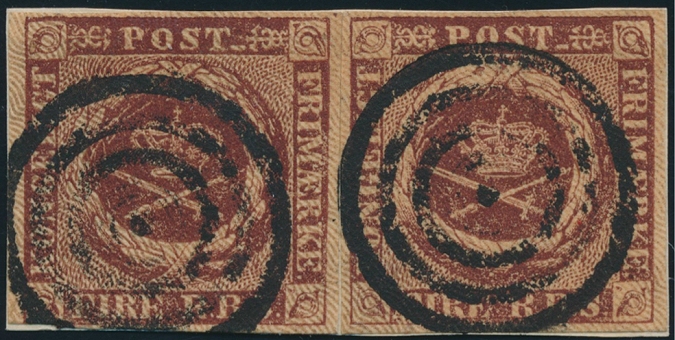
Fig. 1. "Kranholds Retouch", Ferslew Printing, plate II, position no. 5 and no. 6.
(With kind permission of Thomas Høiland, http://www.bruun-rasmussen.dk/).
When I became interested in information about this Kranhold, I asked a number of Danish philatelists, who in one way or another should have some knowledge of the person: Who was he? Considering how many times you've seen the name "Kranhold's Retouch" in the literature, it was quite odd that I only got a few and some
"evasive" answers, but no answer that could bring me significantly closer to the man who discovered the retouch.
However, everyone agreed to be amazed that there wasn't more about him in our philatelic journals Nordisk Filatelistisk Tidsskrift (NFT) or Dansk Filatelistisk Tidsskrift (DFT), but so it is.
A notice in Pierre Terisse's excellent but unfortunately not up-to-date, nor too comprehensive book Filatelistisk Bibliografi, had nothing but an indication of a single article in NFT No. 1 / 1922 where A. A. Kranhold described the inverted watermarks in DK and DWI-stamps. This had very little to do with a retouching in 4 R.B.S. - our first stamp. Pierre Terisse's book cover, moreover, not all philatelist-journals in Denmark, so I may have missed some articles by A. A. Kranhold - but time will show if I have.
Besides the article in the NFT Kranhold had not written anything later - nor with information about the retouch that later was named after him, although he clearly was an experienced philatelist, and a specialist in Danish stamps. The article mentioned that he was from Anoka, Minnesota - living in America.
The only positive information came from our highly esteemed postmark expert Vagn Jensen (d), who always could give a relevant source of reference or two. He said in an e-mail 01.09.2011 (shortly before he passed away) to me - briefly:
"Hi, "Danmarks Frimærker 1851-1924", p. 33. Regards Vagn"
The book "Danmarks Frimærker 1851-1924" - by Chr. Holm and August Petersen - is of large format and was issued by Kjøbenhavns Philatelistklub, 1 May 1925, in connection to the Danish postal service 300-year anniversary, and the article can be found on page 33, and is as follows:
"FOUR R. B. S. Stamps (No.1I, 1II AND 1III).
Ferslew's engraving mark, an F is contained in the wreath to the right just off the M in FRIMÆRKE, as a rule, however, illegible. The so-called Control Signs found in the bottom corner squares - in the left corner a 4, in the right an S, both very small and especial the 4 is often misshapen or filled with colour. An artwork of the control signs are shown in Fig. 22. (The illustrations Fig. 22 and Fig. 23 from the book, however, are omitted here because they are not very clear. TN's annotation.)
Already in the first production of the stamp, one stamp in the sheet's upper row shows that a plate retouch has taken place as the letters in the word POST is substantially shorter and thicker and partially also has different shapes, see Fig. 23. This Retouch was shown by A. A. Kranhold in 1922, and later in the Collectors Club Philatelist, October 1922, had a detailed explanation. (My emphasis. TN). Some confident description can hardly be made on how the retouch was made, but probably a damaged Cliché had been "hammered out" and the letters POST then again engraved."
So for the first time a proper description of the variety - but without naming it "Kranhold's Retouch". But there was a useful reference to an article in the Collectors Club Philatelist, Vol 1, No. 4, October, 1922, p. 145, where Kranhold apparently had described the variety: "The 4 R.B.S. Denmark in 1851."

Collectors Club of New York
I must admit that I had not the slightest knowledge of this "Collectors Club" (I have heard the name, but that was all), which now even has its own page on Wikepedia: Collectors Club of New York. Furthermore the club has its own home page. It was interesting to note that this - in the U.S. highly esteemed club for specialized collectors - was formed in 1896 and therefore is one of America's oldest stamp clubs.
To learn more about Kranhold I wrote to the club's secretary, David K. Steidley and asked whom Kranhold was and asked if it was possible to obtain a copy of his article from 1922. Just a few days later I received a friendly response, in which Steidley wrote that A. A. Kranhold had been a member of the Collectors Club in the
period from 25. September 1924 until 31. October 1934, where his membership had been canceled because of nonpayment of dues. Steidley could not see if Kranhold at the time was dead or simply had failed to pay his dues. However, there was little information about Kranhold's jobs in the club's papers:
"He was Superintendent and Purchasing agent for the Minneapolis, Anoka & Cayuna Range Railroad Company (RRC). This was a trolley line between the nearby towns of Minneapolis and Anoka."
Steidley could not help with a copy of the article because - as he wrote, "we have a little disorder in the archive of our old magazines." He referred me therefore to the American Philatelic Society, which were likely to have the journal Collectors Club Philatelist (CCP).
 |
I did not, but I went instead to my good friend Paul Nelson of Tucson, Arizona, who is a "board member" on the board of The Postal History Foundation, where I also, in
connection with the Nordic stamp exhibition Nordia 2001, which took place in Tucson
recently, became a "member" of the PHF and am named something as special as a "Arizona Philatelic Ranger".
PHF has a very large library, "The Peggy Slusser Memorial Philatelic Library", and also has a complete set of the CCP, and therefore also the number in which Kranhold had written about the retouched stamp.
A few days after Paul sent me several photocopies, both of the few articles that Kranhold had written in CCP, but also of other articles from the CCP on Danish stamps - including some for me so far unknown and very early notices about the Danish Søllested stamp
(so Chapter 4, of my article on that stamp will soon be updated!).
|
As I said there was also a copy of the article where Kranhold described "his" retouch: in Vol. 1, No. 4, p. 145, for October, 1922. This means that Kranhold had submitted the article to the magazine - before he joined the club, but the editor wisely brought Kranhold's article:
The 4 R. B. S. Denmark 1851
By A. A. KRANHOLD
THE re-engraved or recut varieties are rarely found in the early Denmark's. The writer has found three copies of a recut variety in the 4 R. B. S. of 1851 among some thousands of this stamp during the past ten years. All of these three specimens are of the dark brown shade of the second printing. It may be stated that the second printing, consisting of 39,930 sheets was delivered by the printer between March 3rd and 10th, 1852, and was of several shades, firstly of chocolate brown, then dark brown and lastly black brown. The illustration herewith shows the normal and recut variety, latter at the right. A brief description of differences follows:
| Oiginal | Recut |
| "P", "O", "S", and "T" is normal. "O" is normal. | "P" is shorter and narrower.
"O" is more round and with more space in center.
"S" is quite different. Top is more flat and serif at bottom extends out further. "T" shows the most pronounced differences of any of the four letters. Top is considerably wider and serifs shorter. |
The "FR" of "FRIMÆRKE" also shows some differences. It is to be regretted that the reduced illustration of a plate of 100 subjects of this stamp, which appears in Koefoed's "Danske Postfrimærker" (1901), does not show this recut variety. It is obviously on one of the other plates, still in possession of the postal department."

So Kranhold was at that time not a member of the Collectors Club of New York, but as seen, quite conscious about Danish stamps and had also knowledge of Koefoeds book from 1901. As shown later in this article, Kranhold in 1922 had been in contact with the Directorate General of the Danish Post's administrator Olaf Bøgh, by whom he
probably received all the information he had requested.
Kranhold's article in the CCP in 1922 received both attention and recognition, including of John Spohr (who resided in Paris, France), who at that time was a member of Kjøbenhavns Philatelist Klub and a - seen with contemporary eyes - regular contributor of articles to both the CCP and in NFT. According to the article Kranhold had had the opportunity to examine around 1,000 4 R.B.S. stamps for a period of 10 years before he wrote his article. That is, he must have begun his
studies around 1912 - and, as shown by subsequent - in an age of ca. 30 years. In my opinion, a relatively young age for a deep specialized collector of classic Danish stamps. I have not yet managed to find out when he began acquiring his vast collection - perhaps he had inherited some stamps for a start?
In Collectors Club Philatelist, Vol. III. No. 3. July 1924, p. 98
Harry M. Konwiser (who at that time was a member of the KPK) wrote: "Check List on Denmark Number 2" even though he had to explain to readers that the Danish 4 R.B.S. was "Listed as number two in Scott's catalogue. European catalogues refer to this stamp,
properly, as number one, because this stamp preceded the 2 R.B.S. stamp by one month."
"Mr. Kranhold, who has spent many years studying Danish stamps and who is regarded as one of the outstanding experts on the stamps of Denmark, holds three specimens which show "POST" re-engraved on plate, described as follows: "P" in original normal; in this specimen this letter is shorter, with foot narrower. "O" is more round than in normal. "S" is of different shape than normal. "T" has wider top and serifs are shorter. Caduceus is shaped differently.
The numerous shades are classified as follows: Chocolate-brown, first printing. Brown, second printing. Red-brown, second printing. Gray-brown, second printing. Dark-brown, second printing. Black-brown, second printing. Yellow-brown, second printing. Light chestnut-brown, third printing. Dark chestnut brown, third printing. European specialists designate one shade "Kastanie-brown", which might be termed a "mustard" shade ("Chestnut-brown" would have been the correct translation. TN's a.).
Re-engraved or re-cut varieties reported by A. A. Kranhold and proven. All are darkbrown shade, second printing. The second printing, it might be stated, totaled 39,930 sheets, between March 3 and 10, 1852 and the shades appeared in the following order: Chocolate-brown, dark-brown, black-brown.
Showing Recent Variety
Comparing these re-cuts with the normal we find the "P" is shorter and narrower; the "O" is more round and with more space in center; "S" is quite different-top being more flat and serifs at bottom; extends out further; "T" shows most pronounced differences of any four letters, top wider and serifs shorter".
So the retouch was accepted but strangely enough, Kranhold never wrote in NFT about "his" retouch, but there might have been another reason, as he shortly after sold his collection (see below). Furthermore one can wonder why Danish philatelists not even have found a reason to write an article in the NFT about "Kranhold's Retouch"!

Who was A. A. Kranhold?
Since no one in Denmark could answer who A. A. Kranhold was, and - as mentioned - why he had thrown himself into the early Danish stamps, I had to expand my search as it was no good to search the Danish philatelic journals. I began to search for Kranhold's family on the all-encompassing "world wide web" (The Internet).
In my book DDPE about the Danish postal employees, I had made a very substantial part genealogy on "my" postal people to get as much relevant information about each person in my book as possible. It was therefore not difficult for me to try to dig out information on "Kranhold" on the "web" and one should mention, that it was limited how many named "Kranhold" that could pop up during a search.
At http://familysearch.org/ I found only a bit, including that Kranhold had been married to Ruby M. Kranhold and they had two children: Lorraine J. Kranhold and Kathleen J. Kranhold.
Paul Nelson, to whom I had presented the case and who also is an accomplished genealogist and somewhat a specialist with regards to American genealogy sources, found some rather more detailed information http://people.mnhs.org/dci/Search.cfm, where you could just enter the surname Kranhold and search the "All Countys" which gave the following:
Arno A. KRANHOLD:
Resident in Hennepin County, Minnesota, United States.
Birth ("elsewhere") 11 August 1884.
Mother's maiden name: Nienow.
(Certid # 1962-MN-022146).
Died: 18. January 1962 in Hennepin County of Death:
Hennepin Minnesota Death Records Index.
Organization: Minnesota Historical Society.
Collection: Minnesota Death Records Index.
Identifier: 1962-MN-022146th
Americans are (as you know) fond of giving their family members pet/nick names - abbreviations of their common names, so "Arno" might be an abbreviation of "Arnold"? What the following "A" stood for, I didn't knew at this point.

Kranhold's living family
Now the difficult part of the search began: to find living descendants of Arno A. Kranhold who could provide a little more story about him and hopefully a picture of Arno.
As we in Denmark have our online directories Krak and Gule Sider, the U.S. has several online directories and "White pages" where I actually found quite a lot of people with the surname Kranhold, but I had to chose one for a start, so I picked up a Kranhold in Tucson - in the same town where Paul lives. I asked Paul to phone:
Joseph R Kranhold, Tucson, whom I found via http://www.zabasearch.com/.
It was a very good shot, because even though Joe (what Joseph of course is called), a retired physician of 74 years (in 2011), had never heard of A. A. Kranhold before, he had knowledge of a very large publication on the Kranhold family, compiled by a Ken Kranhold in Prescott, Arizona. Joe Kranhold had been at school just a stone's
throw from The Postal History Foundation in Tucson.
Joe Kranhold was obviously interested in our studies and could tell us that the name Kranhold was Prussian - and not Danish. It puzzled him that an American collected Danish stamps, but Paul could, however, reassure him that you really do not have to be a Dane to collect Danish stamps!
Kenneth ("Ken") Kranhold
Joe Kranhold gave Paul Ken Kranhold's phone number, address and e-mail, and a phone call to Ken Kranhold (who also is retired) made him dig deeply in the old family papers and he sent Paul a genealogy listing. Ken Kranhold lives (2011) a relatively short distance from Paul! (Three hours away by car!).
Ken had obviously been curious and searched for "Kranhold's Retouch" on the internet and found a description that more confused than explaining to him what the heck it was all about! Paul and I laughed and we must admit that we to non-collectors easily can be seen as what the U.S. call "nut cases" - ready for to be sent to "the funny farm"! But as said Ken Kranhold provided us with a lot of genealogic data for:
The Kranhold family
emigrated from Straußfurt (Straussfurt), Thuringia (Thüringen), Germany in 1853 and arrived 30 May 1853 to New York aboard the three-masted bark "Rhine" (450 grt, built of wood in 1849 for the Hamburg-Amerikanische Packetfahrt-AG (Hamburg-American Line). She sailed between Hamburg and New York until she was sold in 1858).
On board were Johann Heinrich (John Henry) Kranhold, b. 1 August 1820 in Schilfa, Thuringia, his wife Johanne Christiane Dorothea (born Starke), b. 7 May 1821 in Straußfurt, Thuringia, and their two children: Friedrich Gottlieb (Fred ), b. 19 January 1844 in Straußfurt and Johann August (John August), b. 13 June 1845 in Straußfurt (Ken's great grandfather).
They settled in Wisconsin and here they had two more children: Gustav Adolf Kranhold (Arno's father), born 11 Dec. 1855 in Lebanon, Dodge County, Wisconsin, and Ida Emma Kranhold, b. 1858 in Hustiford, Dodge County, Wisconsin.
|
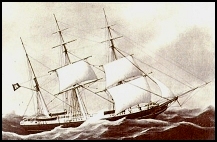
The Bark Rhein. |
First names
In the U.S. censuses one sometimes see slightly different spellings of names for the various Kranhold-persons, e.g. Gustav in the 1860-census is listed as Gusti. In 1870 he is listed as Gustavus.
Similarly for Arno, the midwife's birth certificate calling him "Max" (?) But in the official birth registration he is Arnold. Moreover, it differs a little between Arno / Arnold from census to census, but in the later censuses etc. it is clear that
he preferred to be called Arno.

Gustav Adolf Kranhold.
© 2011. Ken Kranhold / Toke Nørby. |
Gustav Adolf Kranhold
married Louise (Lizzie) W. Nienow 1 Nov. 1883 in Hustiford, Dodge County, Wisconsin, and they had five children, all born in Hustiford:
- Arnold Alexander Kranhold, b. 11 August 1884 - d. 18 Jan. 1962 in Hennepin County, Minnesota.
- Walter Egbert (Richard) Kranhold, b. 18 Feb. 1886 - d. Jan. 1971.
- Leona Marie Kranhold, b. 1 June 1889 - d. 18 August 1972.
- Harry Edgar Kranhold, b. 26 March 1892 - d. 28 Feb. 1959.
- Gertrude Alice Kranhold, b. 12 April 1894 - d. 17 Jan. 1971.
|
Arno Alexander Kranhold
Arno was as mentioned born on 11 August 1884 in Hustiford, Dodge County, Wisconsin, son of Gustav Adolph Kranhold and Louise W. Nienow. He married Ruby M. Stanchfield around 1908 and they had two children - Lorraine Jeanette Kranhold (b. 17 April 1910 - d. 11 July 1987) and Kathleen Louise Kranhold (b. 26 Nov 1912 - d. 22 Feb. 2005).
Arno's civilian career, drawn from various census records and city directories was as follows:
- 1890-1900 Clerk for C M S P & P RR (ie at a very young age!)
- 1900 Laborer in RR depot.
- 1909 Working for Northern Demurage Bureau, b, 1112 Logan Ave N.
- 1910 Accountant-railroad
- 1914 Traffic manager Minneapolis & Northern RR Co. Home: 1214 James Ave N.
- 1920 Superintendent, Electric Railroad in Railroad in Anoka.
- 1930 Salesman - automobiles in Minneapolis.
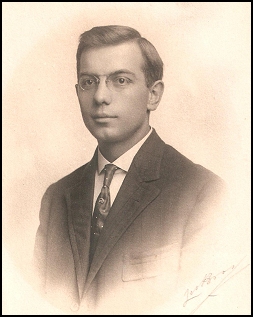
A. A. Kranhold approx. 1908.
© 2011. Margit Livingston / Toke Nørby.
Arno's daughter Sandra has in her story about the family characterized Arno "Alex" Kranhold in this way:
"Perfektionist, gentle man, complex personality, telegrapher, card player, sportsman, reader, writer, musician, dancer, businessman, stamp collector, coin collector, scholar, brother, son, father and grandfather!"
|
Although Ken provided us with a great deal of information about the Kranhold family, I'll limit the family history here and just mention that one of Kranhold's daughters, Lorraine Jeanette Kranhold around 1945 married Raymond Fredrick Livingston. They had two daughters and one of them, Margit ("Maggie") Livingston (born 1950) is (in 2011) a law professor at De Paul University College of Law in Chicago, and I came in contact with her! She had fortunately a very nice photo of her grandfather Arno, taken around 1908 when he was married to Maggie's grandmother.
Maggie also said that her grandfather owned a lamp shade factory during the 1920s, but in the 1930s great depression in the U.S., he gave up this factory. She also said that Kranhold had no special education, but he had been something of a bookworm and quite intellectual, as his studies of Danish stamps certainly confirms. Maggie Livingston was aware of her grandfather's philatelic interest, but not in detail.
Kranhold divorced, sold his collection and got married again!
We do not know why Kranhold stopped collecting Danish stamps, but he may have needed money in the early 1920s when he divorced his first wife around the time he sold his collection. It may have been of simple necessity - and he had probably received an offer he could hardly say "No, thanks" to.
Arno was, after divorcing his first wife, married in Indiana 14 Dec. 1929 to Myrtle Scovell (b. 26 July 1894 - d. 5 Jan. 1977. Some online directories spell the name Scovelle). They had a daughter, Sandra Lee Kranhold (b. 12 July 1932 - d. 23 August 1991). Sandra "Sandy" was later married: Sandra Lee Erickson. She had three childen and one of them is Nancy Kay Erickson (b. 15 Dec. 1957) with whom I have been exchanging e-mails. Her parents named her Kay for her grandfather Kranhold as he often was called "K" by his friends. She has a Ph.D. from the University of Michigan and is Associate Professor of French, at the University of Southern Maine. Sandra's other children are Ross Allen Erickson (b. 23 July 1961) and Margaret "Peggy" Eileen Erickson (b. 11 Jan. 1956) - later on 11 Nov. 1983) married to Douglas Merle Spurgeon. Peggy is the family genealogist!
Not much more has to be said here about Arno Alexander Kranhold's private career, but of course you can follow the family up to the present time if you want.
|

Kranholds philatelic career
So now we have learned about A. A. Kranhold, as he always signed himself, that he was born in Wisconsin, and his family moved to Anoka probably sometime in the 1890s. We do not know how this man, of Prussian descent, and with an education that was less than a high school education, became interested in classic Danish philately, or
how he came into contact with the highly prestigious Collectors Club of New York.
His philatelic career is obviously of great interest to us in Denmark, and it is obvious that he at one time or another in a relatively young age had acquired or may have inherited a very nice collection of Danish stamps. As yet it is not known how he began collecting, or what the reason was why he chose to collect Danish stamps.
Likewise, we can see that he mastered the studying of his stamps and that he was a highly recognized philatelist in the 1920s, which his articles in the Collectors Club Philatelist and responses so clearly demonstrates.
The first described retouch in 4 R.B.S.
Kranhold was therefore the first ever to describe a retouch in our 4 R.B.S. stamps - as the article reproduced above shows. Later, other retouched stamps were found, which include the shown later descriptions of our first stamp.
None of the descendants with whom I have been in contact with knows if Arno's interest for stamps came back - probably it did not.
Charles James Phillips
According to a footnote in the Collectors Club Philatelist Vol. IV, no. 4 / October 1925, Kranhold sold his stamp collection to the famous Charles James Phillips, who in 1925 published the book: "Denmark from 1851 to 1899: Detailed, Descriptive, Priced Catalogue of the Early Issues, Together with Lists and Prices of the Numeral Cancellation" largely based on a description of Kranhold's collection. Below is an abstract from the book:
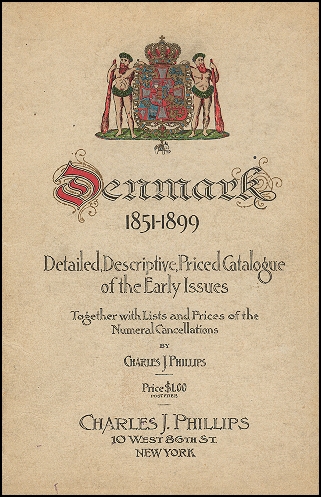
|
INTRODUCTION
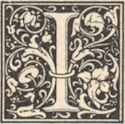 N 1925 I purchased the special collection of Danish Stamps formed during the past twenty years by Mr. A. A. Kranhold of Anoka, Minnesota, U.S.A. Mr. Kranhold has been indefatigable for many years in gathering together an enormous collection of his favorite country. N 1925 I purchased the special collection of Danish Stamps formed during the past twenty years by Mr. A. A. Kranhold of Anoka, Minnesota, U.S.A. Mr. Kranhold has been indefatigable for many years in gathering together an enormous collection of his favorite country.
In unused he has endeavored to get all possible shades and varieties, then pairs and blocks, and finally entire sheets, especially in those issues having the frames inverted, which he specially studied and in which he has searched the world for sheets and large blocks showing different "make ups" of the frames and the central key plates.
In the used he has specialized in stamps on covers and above all in the issues of 1851 to 1871 with all obtainable numeral cancellations on all values.
It seems to me a thousand pities that when such a famous collection has to be dispersed, the result of many years of painstaking research is so often lost to the Philatelic world, as such collections are priced and retailed by dealers, or sold at auction, without any record being printed which might be of interest to students in the future.
In this collection we have many hundreds, some- times over a thousand, of one stamp with a vast number of the interesting numeral cancellations. When these are sorted out and classified one soon learns that certain numerals are very common and others are exceedingly rare. In sorting one value of one issue I found over 200 stamps of No. 1 and of many small towns I only found one copy.
I finally decided to write a detailed catalogue and price everything I had as my small contribution to the study of this interesting little country and to indicate-as well as I know how-the relative rarity of varieties as I find them in this collection.
Experts will please pardon me if I make many blunders, as this little brochure is not based on long and close study but is just what I have learned in a few months from the Kranhold collection only.
In conclusion I wish to say that I have drawn freely on the following authorities:
Danmarks Frimærker, 1851-1924, published by the Kjøbenhavns Philatelistklub, 1925. Kohl Briefmarken Handbuch, edited by Dr. Herbert Munk.
Several articles in The London Philatelist, and The Collectors Club by A. A. Kranhold; John Spohr; H. M. Konwiser and R. B. Yardley.
I am specially indebted to Messrs. A. A. Kranhold and A. E. Pade for many corrections and suggestions for this catalogue.
|

Page 6 and 7 of the total of 52 pages in the catalogue. "POST recut" was Philips designation for "Kranhold's Retouch".
|

The sale of Kranhold's collection in 1928
A few years later on 7 May 1928 Kranhold's collection was sold by the auction house HR Harmer Auctions in London and I wrote them and asked if they still had their old catalogue of this sale - and they had! I received a friendly response from Harmer's:
"Please find attached scans of catalogue including Photo-plates.
With regards,
Miro Svoren
Harmers of London
No. 11, 111 Power Road
Chiswick, London"


Front cover from the sales catalogue
with A. A. Kranhold's collection. |
Harmer made a nice advertisement for the sale, which also included a number of absolute gems - also seen with today's eyes, including multiple copies of 4 R.B.S. Ferslew and Thiele stamps with "Retouched Post" (which at that time was not yet called "Kranhold's Retouch"):
Particular attention is drawn to the dispersal of this fine collection, which is the largest and most important collection of Danish stamps ever offered in Auction. Nearly all the stamps are unused, used stamps only being included when unusual pieces, or extreme rarities, or unobtainable in unused condition. The blocks of early imperforates and the fine range of early perforated issues in uncut original sheets are the outstancling feature of this exceptionally fine collection.
The only "Kranhold's Retouch" which was pictured in the catalogue was this:


Whoever owns this stamp today, in my opinion, has an exceedingly beautiful philatelic-historical item!
Another retouch mentioned in the catalogue, but without being depicted, was:

|

Kranhold stayed connected with the Danish postal museum
Apart from the information that Kranhold gave of the second print runs of the 4 R.B.S., it is certain that he has been in contact with the postal museum in Copenhagen, where Olaf (Theodor Nicolaj Sejdelin) Bøgh in 1922 was a clerk in the Danish General Directorate (GD) of the Post and helped the then administrator of the GD, Emil Valdemar Holm, with its stamp collection. He collected new stamps from around the world for the postal collection of stamps. Furthermore, Bøgh collected physical postmarks and took early impressions of these either on plain paper or on Danish stamps - typically on 1-Øre stamps - both for his own interest and but also as a kindness to collectors, who requested the impressions.
As shown below Bøgh sent a postcard to Kranhold in 1922. Bøgh had amused himself by constructing a "fantasy" card, but it clearly shows one thing: Kranhold had contact with the postal museum in Denmark in 1922:
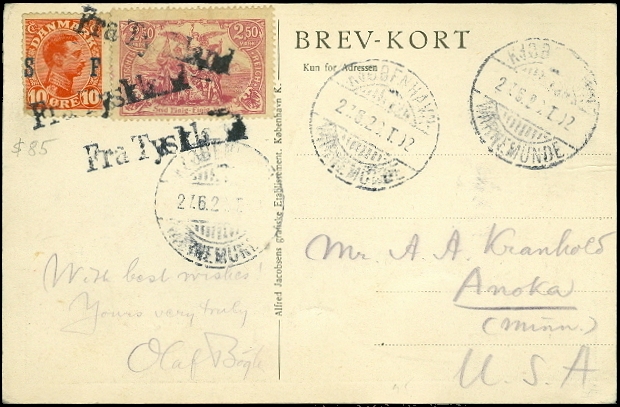
The date setting in the stamp indicates that the date is 27 June 1922.
It is not entirely certain that this card has been sent normally - but it probably has.
(I bought it from a US stamp dealer! who asked for $75!!! for a $2 item you normally never will buy! :-).
At the postal museum in Denmark I have sought for a correspondence between Bøgh and Kranhold but no such correspondence seems to exist. So it will probably never be verified if Bøgh just wished to enjoy Kranhold sending him this postcard referring to his Prussian descent by using the line mark "Fra Tyskland" ("From Germany") and the German stamp. Why he added the Danish SF-stamp (a Soldier's stamp) is hard to understand. Furtheremore Bøgh shows Kranhold's connection to Germany by using the special GPO-postmark Copenhagen-Warnemünde!
The postmark registration of Vagn Jensen (d) / KPK shows us that the "Fra Tyskland" (RAM and LIN postmark - framed and line postmark) is known in use at two GPOs, Copenhagen-Warnemünde and Fredericia-Flensburg. Arnholtz (p. 100) note that 1 RAM and 2 LIN "Fra Tyskland" at Copenhagen-Warnemünde GPO, while JKE in Nordfrimex 83 catalogue indicates 1 LIN 1909-1912 and that "there are several not yet dated such postmarks". One must assume that there are 4 "Fra Tyskland"-postmarks, one for each postmark Kjøbenhavn-Warnemünde, and that they have been out of use in the period 1914-22. LIN is known to be in use again in 1923.

(With kind permission of Vagn Jensen (d) / KPK).
So Bøgh can actually in 1922 have had access to the two hand stamps before they were put into regular use again.

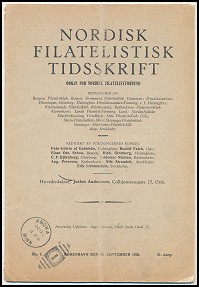 Apparently Kranhold never again took up collecting Danish stamps, at least not at a higher level where he felt compelled to write about them. There are - to my I knowledge - not articles of A. A. Kranhold after he sold his Danish collection. Arno died as mentioned 18 January 1962 in Hennepin County, Minnesota. Apparently Kranhold never again took up collecting Danish stamps, at least not at a higher level where he felt compelled to write about them. There are - to my I knowledge - not articles of A. A. Kranhold after he sold his Danish collection. Arno died as mentioned 18 January 1962 in Hennepin County, Minnesota.
Nancy Kay Erickson, Arno's grandchild from his second marriage, has sent me many scannings of papers about Arno. They show that Arno had been into contact with many of the leading philatelists in the world, Roland King-Farlow, Ernst M. Cohn (who once wrote to Arno that he was sorry that he was only 5 years old when Arno sold his stamp collection!). Furthermore with G. A. Hagemann (who in 1924 wrote to Kranhold on a piece of paper market "Bergsjöholms Godskontor, Ystad" - Sweden).
Nancy was kind enough to ask me if I was interested in any of the letters Kranhold had received from philatelists, but I did not think those letters should leave the family. On the other hand, Nancy had sent me a scan of the magazine NFT No. 7/1928, which in the lower left corner on the front has the arrival machine cancellation in "ANOKA / Oct. 16. 4 P.M. / MINN." (Minnesota). It is quite certain that Kranhold has had hold the magazine in his hands and left some invisible fingerprints, so I would very much like to say "Yes, please" to her kind offer, and it came in the mail a few weeks later - Thank you very much, Nancy!
Also scannings of Arno's originale manuskript: "Denmark and Danish West Indies. A Study of Printing of the Bi-coloured Issues - 1875 - 1905. by A. A. Kranhold". and his manuscript with "A list of Stamps existing with Inverted Watermark".

Epilogue
On the following page a few letters to Kranhold from a few of our famous philatelists. The letters shows clearly their recognition of Kranhold's pioneering work. Also shown are a few pictures from Nancy's family album:
Kranhold-Epilogue (In English only).
|
![]()
![]()
